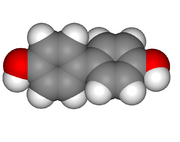
| |

| |
| Names | |
|---|---|
| Preferred IUPAC name
[1,1′-Biphenyl]-4,4′-diol | |
| Other names
4,4′-Dihydroxybiphenyl
4,4′-Diphenol 4,4′-Biphenyldiol | |
| Identifiers | |
3D model (JSmol)
|
|
| ChEBI | |
| ChEMBL | |
| ChemSpider | |
| ECHA InfoCard | 100.002.001 |
| EC Number |
|
| KEGG | |
PubChem CID
|
|
| UNII | |
CompTox Dashboard (EPA)
|
|
| |
| |
| Properties | |
| C12H10O2 | |
| Molar mass | 186.210 g·mol−1 |
| Appearance | colorless or white solid |
| Melting point | 283 °C (541 °F; 556 K)[1] |
| Boiling point | Sublimes |
| Insoluble in water Soluble in ethanol and ether | |
| Hazards | |
| Flash point | > 93.3 °C (199.9 °F; 366.4 K) |
| Safety data sheet (SDS) | MSDS |
Except where otherwise noted, data are given for materials in their standard state (at 25 °C [77 °F], 100 kPa).
| |
4,4′-Biphenol is an organic compound which is a phenolic derivative of biphenyl. It is a colorless solid.
4,4′-Biphenol is prepared by dealkylation of the tetra-t-butyl derivative, generated by the oxidative coupling of 2,6-di-tert-butylphenol. The oxidative coupling of phenol itself typically gives a mixture of isomers.[2] For example, VCl4 reacts with phenols give 4,4′-, 2,4′-, and 2,2′-biphenols:[3]
- 2 C6H5OH + 2 VCl4 → HOC6H4–C6H4OH + 2 VCl3 + 2 HCl
An earlier process using oxygen and copper salts to enable the oxidative coupling was reported [4]
Safety[edit]
4,4'-Biphenol had actually been elucidated to have an estrogenic SAR.[5]
See also[edit]
References[edit]
- ^ Chen, Guoliang; Du, Fangyu; Zhou, Qifan; Liu, Dongdong; Fang, Ting; Shi, Yajie; Du, Yang (2018-01-31). "Dimerization of Aromatic Compounds Using Palladium-Carbon-Catalyzed Suzuki–Miyaura Cross-Coupling by One-Pot Synthesis (Supporting Information)". Synlett. 29 (6): 779–784. doi:10.1055/s-0036-1591892. ISSN 0936-5214. S2CID 104289422.
- ^ Helmut Fiege; Heinz-Werner Voges; Toshikazu Hamamoto; et al. (2002). "Phenol Derivatives". Ullmann's Encyclopedia of Industrial Chemistry. Weinheim: Wiley-VCH. doi:10.1002/14356007.a19_313. ISBN 3527306730.
- ^ O’Brien, M. K.; Vanasse, B. (2004). "Vanadium(IV) Chloride". In Paquette, L. (ed.). Encyclopedia of Reagents for Organic Synthesis. New York, NY: J. Wiley & Sons. doi:10.1002/047084289X.rv001. ISBN 0471936235.
- ^ Hay, Allan (1971). "Coupling of Phenols With Diphenoquinones". US Patent 3,631,208. Retrieved 5 March 2020.
- ^ Dodds, E. C.; Lawson, W. (1937). "A Simple Aromatic oestrogenic Agent with an Activity of the Same Order as that of estrone". Nature. 139 (3519): 627–628. doi:10.1038/139627b0. ISSN 0028-0836. S2CID 4119670.